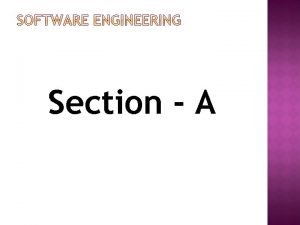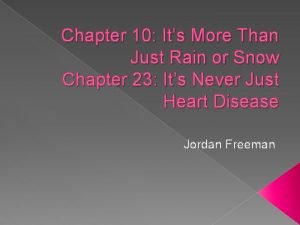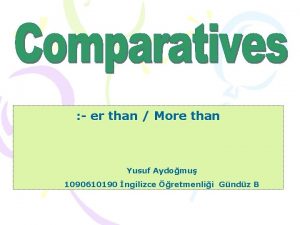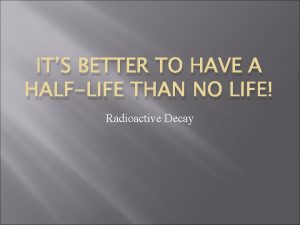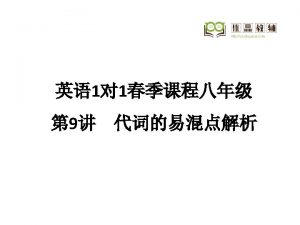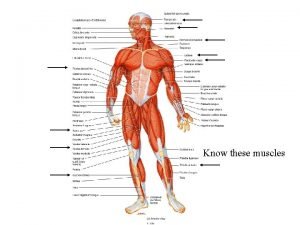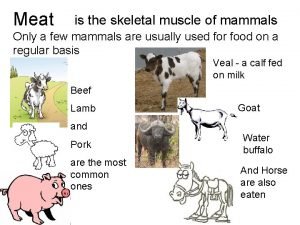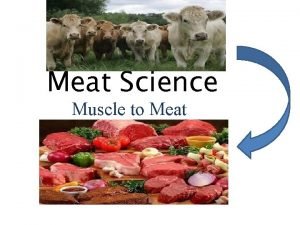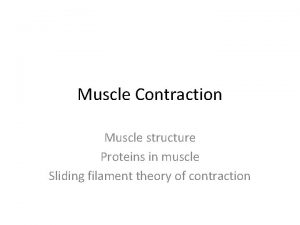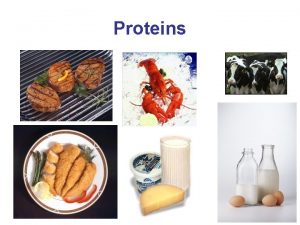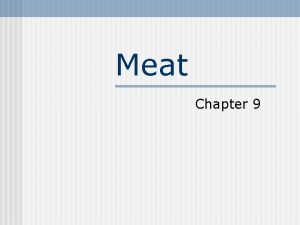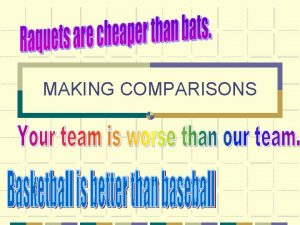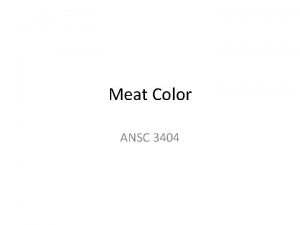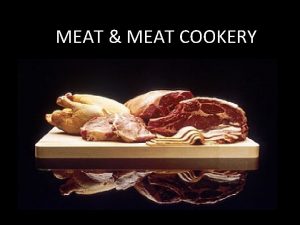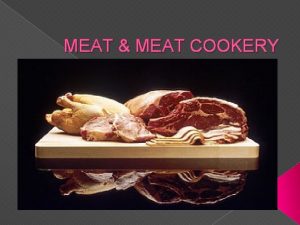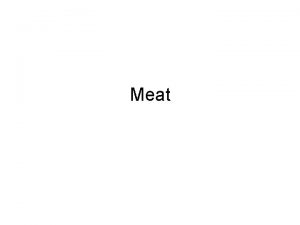PROTEINS MORE THAN JUST MEAT AND MUSCLE Chapter














- Slides: 14

PROTEINS: MORE THAN JUST MEAT AND MUSCLE Chapter 5

Proteins • Recognized as the fundamental structure of every cell in the body. • It is a macronutrient; energy level of 4 kcal per gram • Made up of carbon, hydrogen, oxygen, nitrogen. They also have sulfur and phosphorus. • They have large molecular weights ranging from 35, 000 to millions. Some large molecules cannot pass through cell membranes. • All allergens are of protein source

Proteins Function and Foods • Foods high in protein: meats, eggs, dairy products, beans, nuts, soy, and legumes. • A good quality protein (complete protein) is one that supplies all the essential amino acids in sufficient quantities and in proper ratio for normal growth and maintenance. • Proteins from animal sources are complete proteins meats, poultry fish, eggs, milk and cheese. • Incomplete protein is gelatin ( form connective tissue or skin of animals)

Protein Function and Foods • Proteins from plant sources are not good quality proteins because they are in short supply of lysine, threonine, methionine, and tryptophan. • The best quality of protein found in plant sources are beans, peanuts, and nuts. • Proteins are made up of combinations of amino acids linked together by peptide bonds. • Foods contains different amino acids and their levels vary.

Chemical Structure of an Amino Acid The R Groups are Unique with amino acids. The R Group determines the function of each amino acid.

Essential Amino Acids - Proteins that have all 9 essential amino acids are good quality proteins. • Essential Amino Acids • • Histidine • • Leucine • • Methionine • • Threonine • Isoleucine • Lysine • Phenylalanine • Tryptophan • • Valine Essential Amino Acids – Cannot be made in the body, must obtain from food.

Non-Essential Amino Acid • Alanine • Asparagine • Cysteine • Glutamine • Proline • Tyrosine • Arginine • Aspartic Acid • Glutamic Acid • Glycine • Serine Body can make Non-Essential Amino Acids

Protein Function • Growth, Maintenance, and Repair • Proteins aid in proper growth and development. • Builds muscles and repair connective tissues. • Proteins are constantly being broken down and synthesized. • Amino acids (non essential amino acids) are reused to make new protein, but essential amino acids must be replaced through the diet. • Enzymes are proteins that speed up chemical reactions. • Enzymes are specific reactions in every cell. • Enzymes keep the body functioning properly. • Enzymes throughout the digestive system (mouth, esophagus, stomach, small intestine, and large intestine) to aid in digestion (protein, fat, and carbohydrate)

Proteins Function • Body Structure and Blood Clotting • Builds muscle mass • Important in blood clotting • Protein is collagen which makes up the connective tissue, skin, bones, teeth, and blood vessels. • Major component of hair and nails • Fluid Balance • Plays a role in maintaining fluid balance. Maintains balance between the cell spaces and the capillary vessels to prevent swelling (edema). • Proteins in the blood keeps optimal balance between the fluids inside and outside of your cells and blood vessels.

Protein Function • Acid-Base Balance • Protein help maintain the p. H range in the body by acting as a buffer and help neutralize the p. H when too many hydrogen ions are present and threaten to make the blood acidic. • Immune Function • Protein deficiency limits your ability to fight infection and recovery from injury. • White blood cells are a protein-rich component of your blood. They eat bacteria, attack viruses, and parasites. Aid in allergic response, and eat foreign substances and pathogens and then attract antibodies and other molecules to further attack the invaders

Protein Function • Hormones • Some hormones are made from proteins. • Insulin is a hormone made from proteins that lowers blood glucose levels. • Transport • Proteins acts as a sodium-potassium pump to help maintain the balance of sodium and potassium between the outside and inside of the cell. • Energy • Protein is used for energy if carbohydrates are too low. • When protein is used as energy for prolonged periods, the protein will be takes from body tissue (muscle); loss of muscle tissue. • Important that fat and carbohydrates are used for energy.

Sources of Proteins • Low in Fat • See pg 149 (application tips) • Soy Products • Provides a good source of protein with little saturated fat or cholesterol. • Contains isoflavonoids which protects cells against damage, prevent symptoms of menopause and osteoporosis, and lower cholesertol when used to animal sourced products. • Protein Supplements • Shakes, pills, bars, pudding, and etc. • High protein alternatives in generally with less fat

Consuming Excess Protein Than Daily Needs • No health benefits associated with excess protein • Protein will be used for energy or stored as fat; possible weight gain • Creates an imbalance when you are not consuming enough of the other food groups. Lead to health illness such as cholesterol issues, osteoporosis, kidney disease, and etc. • Too much saturated fat, inadequate amount of calcium, and stress on kidney due to high protein • Body must get rid of nitrogen groups of amino acids, so more water intake is need to flush the system.

Consuming Too Little Protein • Less protein than daily recommended amounts for prolonged periods can lead to protein energy malnutrition. • Protein Energy Malnutrition (PEM)– not consume adequate amount of protein, calories or both. • Diagnosed in US and especially foreign countries; some children have a slower than normal growth rate to PEM. • PEM may lead to skeletal or potbell appearance due to inadequate amount of protein and calories. • May occur in people who are in starvation, cancer and/or HIV patients due to treatments, and infants and children with gastrointestinal disease due to malabsorption.
 Lirik lagu more more more we praise you
Lirik lagu more more more we praise you More more more i want more more more more we praise you
More more more i want more more more more we praise you Software is more than just
Software is more than just Bingo bins mortdale
Bingo bins mortdale Math is more than just numbers
Math is more than just numbers It's more than just rain or snow
It's more than just rain or snow Thousands of possibilities get yours slogan
Thousands of possibilities get yours slogan More er than
More er than 5730x5
5730x5 Greater than god and more evil
Greater than god and more evil Muscular tissue function
Muscular tissue function Market forms of chicken
Market forms of chicken Why does juliet kiss romeo in the tomb
Why does juliet kiss romeo in the tomb What is skeletal meat
What is skeletal meat Fusiform fibers smooth muscle
Fusiform fibers smooth muscle


